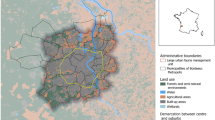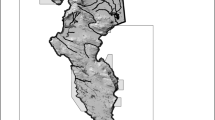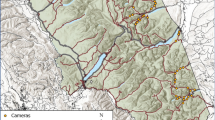Abstract
We investigate conflicts between wildlife conservation and recreational use that can occur at open-access sites when visitors dislike crowding. A theoretical model is proposed which determines the spatial distributions of visitors to a beach, given their willingness to walk to avoid crowding and the configuration of beach access points. This model is estimated for three sections of coastline in eastern England using data from aerial video photography. Visitor density is strongly and negatively correlated with distance from access points. Willingness to walk has a highly skewed population distribution. We discuss the implications of these findings for the management of conflicts between conservation and recreation at open-access sites.





Similar content being viewed by others
Notes
See, for example, De Ruyck et al. (1997a), Dharmaratne and Braithwaite (1998), Tunstall et al. (1998), Hanley et al. (2003), Chen et al. (2004), and Kubas et al. (2005). Coombes et al. (2009) investigate demand for beach use at a finer spatial resolution, but do not consider the effects of crowding.
DeRuyck et al. (1997b) investigate beach use at an extreme micro level, counting the number of tourists in 10-m grid squares on two dates at three South African beaches. They find that, at this level of spatial resolution, the distribution of tourists is clustered. This level of resolution is too fine to pick out any tendency for parties of visitors to separate themselves from one another.
This light-touch approach to achieving policy objectives without using either overt prohibitions or monetary charges has some similarities with the ‘nudge’ approach advocated by Sunstein and Thaler (2003). However, unlike policies motivated by Sunstein and Thaler’s ‘libertarian paternalism’, a policy of increasing the distance that visitors have to walk to reach environmentally sensitive locations is not paternalistic, and its effectiveness does not depend on individual irrationality.
Formally, the distinction between goods and bads is merely the direction in which they are measured. Whether one defines preferences over combinations of the bads of distance and crowding or over combinations of their negatives (the goods of ‘accessibility’ and ‘solitude’) is a matter of notational convenience.
It is not clear whether either of these two types of beach use creates systematically more wildlife disturbance than the other. Movement in itself can be a cause of disturbance, but so too can prolonged human presence in one location. The beach areas that are favoured by picnickers and sunbathers (typically around the high-tide line) may be more susceptible to disturbance than the more seaward areas that are often easier to walk on.
Linearity of the utility function is convenient but not essential for the main conclusions of our model. What is essential is that the subjective trade-off between distance and crowding is represented by a single ‘willingness to walk’ parameter which can take different values for different individuals, and that at every point in \(<\)distance, crowding\(>\) space, the marginal rate of substitution between crowding and distance (in the linear model, \(-1/\alpha _{i})\) increases monotonically with the value of that parameter. Non-homogeneity in subjectively-valued beach characteristics could be taken into account by adding additional arguments to the utility function. This would not require major changes to the model, provided that \(\alpha _{i}\) remained the only individual-specific utility parameter.
This result holds for a wide range of plausible utility functions, and not merely the linear function (1).
To see why this is not invariably the case, consider the example presented in Sect. 3 under the assumption of a bimodal distribution of willingness-to-walk. Option 2 increases the value of \(u^{*}(\alpha )\) at \(\alpha = 3\). Intuitively, visitors with high willingness-to-walk may benefit from reductions in accessibility which concentrate other visitors into shorter lengths of beach.
Since such people are typically observed at locations that are more crowded than those that at which they choose to settle down, this imparts a downward bias to our estimation of the population distribution of the willingness-to-walk parameter. However, for the reasons explained in Sect. 2, we think that the effect of this bias is relatively small, except perhaps at the upper extreme of the willingness-to-walk distribution.
References
Bateman IJ, Abson D, Beaumont N, Darnell A, Fezzi C, Hanley N, Kontoleon A, Maddison D, Morling P, Morris J, Mourato S, Pascual U, Perino G, Sen A, Tinch D, Turner RK, Valatin G, Andrews B, Asara V, Askew T, Aslam U, Atkinson G, Beharry-Borg N, Bolt K, Cole M, Collins M, Comerford E, Coombes E, Dugdale S, Dunn H, Foden J, Gibbons S, Haines-Young R, Hattam C, Hulme M, Ishwaran M, Lovett A, Luisetti T, MacKerron G, Mangi S, Moran D, Munday P, Paterson J, Resende G, Siriwardena G, Skea J, van Soest D, Termansen M (2011) Economic values from ecosystems. The UK national ecosystem assessment technical report. UNEP-WCMC, Cambridge
Champ PA, Boyle K, Brown TC (eds) (2003) A primer on non-market valuation, the economics of non-market goods and services, vol 3. Kluwer, Dordrecht
Chen W, Hong H, Liu Y, Zhang L, Hou X, Raymond M (2004) Recreation demand and economic value: an application of travel cost method for Xiamen Island. China Econ Rev 15:398–406
Coombes EG, Jones AP, Bateman IJ, Tratalos JA, Gill JA, Showler DA, Watkinson AR, Sutherland WJ (2009) Spatial and temporal modeling of beach use: a case study of East Anglia, UK. Coast Manag 37:94–115
De Ruyck AMC, Soares AG, Frssaf AM (1997a) Human recreational patterns on beaches with different levels of development. Trans R Soc S Afr 52:257–276
DeRuyck MC, Soares AG, McLachlan A (1997b) Social carrying capacity as a management tool for sandy beaches. J Coast Res 13:822–830
Dharmaratne GS, Braithwaite AE (1998) Economic valuation of the coastine for Tourism in Barbados. J Travel Res 37:138–144
Dominguez J, Vidal M (2003) Influence of researchers on the breeding success of Kentish plovers Charadrius alexandrinus. Ardeola 50:15–19
Garcia C, Servera J (2003) Impacts of tourism development on water demand and beach degradation on the island of Mallorca (Spain) Geografiska Annaler series a-physical. Geography 85A:287–300
Hanley N, Bell D, Alvarez-Farizo B (2003) Valuing the benefits of coastal water quality improvements using contingent and real behaviour. Environ Resour Econ 24:273–285
Kubas A, Yilmaz F, Aktas Y, Metin N (2005) Analysis of visitor decision making system when visiting natural recreation sites by multinomial logit model. Qual Quant 39:615–623
Liley D, Sutherland WJ (2006) Predicting the consequences of human disturbance for Ringed Plovers Charadrius hiaticula: a game theory approach. Ibis 149(Suppl 1):82–94
Mallord JW, Dolman PM, Brown AF, Sutherland WJ (2007) Predicting the consequences of recreational disturbance for a woodlark Lullula arborea population on heathlands in southern England. J Appl Ecol 44:185–195
McClung MR, Seddon PJ, Massaro M, Setiawan AN (2004) Nature-based tourism impacts of yellow-eyed penguins Medadyptes antipodes: does unregulated visitor access affect fledging weight and juvenile survival? Biol Conserv 119:279–285
Parker GA, Sutherland WJ (1986) Ideal free distribution when individuals differ in competitive ability: phenotype-limited ideal free models. Animal Behav 34:1222–1242
Ruhlen TD, Abbott S, Stendahl LE, Page GW (2003) Evidence that human disturbance reduces snowy plover chick survival. J Field Ornithol 74:300–304
Sunstein CR, Thaler RH (2003) Libertarian paternalism. Am Econ Rev Pap Proc 93:175–179
Sutherland WJ, Parker GA (1985) The distribution of unequal competitors. In: Smith RH, Sibly RM (eds) Behavioural ecology: the ecological consequences of adaptive behaviour. Blackwell, Oxford pp 255–278
Sutherland WJ, Parker GA (1992) The relationship between continuous input and interference models of ideal free distributions with unequal competitors. Animal Behav 44:345–355
Tratalos JA, Gill JA, Jones A, Showler D, Bateman I, Watkinson AR, Sugden R, Sutherland WJ (2011) Regional models of the influence of human disturbance and habitat quality on territory choice by ringed plover Charadrius hiaticula and oystercatcher Haematopus ostralegus. University of East Anglia, Working paper
Tunstall SM, Penning-Rowsel EC (1998) The English beach: experiences and values. Geogr J 164:319–332
Acknowledgments
We would like to thank the NERC/ESRC/EPSRC for funding this work through the Tyndall Centre for Climate Change Research. WJS is funded by Arcadia. Viola Kimmel and Emma Coombes digitised the locations of visitors to the beach. Ordnance Survey kindly provided the MasterMap data: \(\copyright \) All Rights Reserved, Ordnance Survey Licence Number 10024462, 2003. Amy Doherty provided meteorological data. We thank two anonymous referees for comments on a previous version of the paper.
Author information
Authors and Affiliations
Corresponding author
Rights and permissions
About this article
Cite this article
Tratalos, J.A., Sugden, R., Bateman, I.J. et al. The Conflict Between Conservation and Recreation When Visitors Dislike Crowding: A Theoretical and Empirical Analysis of the Spatial Distribution of Recreational Beach Users. Environ Resource Econ 55, 447–465 (2013). https://doi.org/10.1007/s10640-013-9634-2
Accepted:
Published:
Issue Date:
DOI: https://doi.org/10.1007/s10640-013-9634-2




